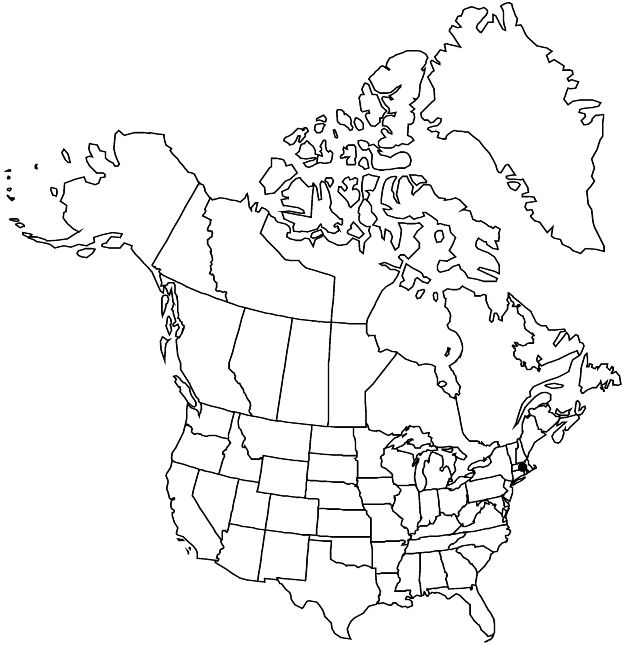Difference between revisions of "Crataegus ×bicknellii"
Bull. Torrey Bot. Club 38: 244. 1911.
FNA>Volume Importer |
FNA>Volume Importer |
||
| Line 33: | Line 33: | ||
|elevation=0–10 m | |elevation=0–10 m | ||
|distribution=Mass. | |distribution=Mass. | ||
| − | |discussion=<p>Crataegus ×bicknellii is known only from Nantucket Island; it is a good example of a small population of a rare hawthorn known to have persisted about 100 years. Palmer assigned C. ×bicknellii to C. chrysocarpa; it is not much like var. chrysocarpa in leaf shape, indumentum, or glandularity, nor in its striking laciniate sepals, nor purple anthers. Crataegus ×bicknellii also flowers much later than the C. chrysocarpa group. The author agrees with E. P. Kruschke (1965) that it is closest to C. sylvestris. The specimens seen by the author have glabrous pedicels in contrast to the slightly villous pedicels reported by Eggleston and Palmer. The flowers in recently collected material are fewer per inflorescence and much larger than described in the protologue.</p> | + | |discussion=<p><i>Crataegus ×bicknellii</i> is known only from Nantucket Island; it is a good example of a small population of a rare hawthorn known to have persisted about 100 years. Palmer assigned <i>C. ×bicknellii</i> to <i>C. chrysocarpa</i>; it is not much like <i></i>var.<i> chrysocarpa</i> in leaf shape, indumentum, or glandularity, nor in its striking laciniate sepals, nor purple anthers. <i>Crataegus ×bicknellii</i> also flowers much later than the <i>C. chrysocarpa</i> group. The author agrees with E. P. Kruschke (1965) that it is closest to C. sylvestris. The specimens seen by the author have glabrous pedicels in contrast to the slightly villous pedicels reported by Eggleston and Palmer. The flowers in recently collected material are fewer per inflorescence and much larger than described in the protologue.</p> |
|tables= | |tables= | ||
|references= | |references= | ||
| Line 57: | Line 57: | ||
|publication year=1911 | |publication year=1911 | ||
|special status=Endemic | |special status=Endemic | ||
| − | |source xml=https://jpend@bitbucket.org/aafc-mbb/fna-data-curation.git/src/ | + | |source xml=https://jpend@bitbucket.org/aafc-mbb/fna-data-curation.git/src/8f726806613d60c220dc4493de13607dd3150896/coarse_grained_fna_xml/V9/V9_1092.xml |
|subfamily=Rosaceae subfam. Amygdaloideae | |subfamily=Rosaceae subfam. Amygdaloideae | ||
|tribe=Rosaceae tribe Gillenieae | |tribe=Rosaceae tribe Gillenieae | ||
Revision as of 19:14, 18 September 2019
Shrubs or trees, 30–80 dm. Stems: twigs: new growth greenish, glabrous, 1-year old tan, older darker or grayer; thorns on twigs few to numerous, 1-year old dark brown, ± stout, 2–6 cm. Leaves deciduous; petiole slender, length 50–70% blade, adaxial sulcus sparsely hairy, eglandular to barely glandular; blade broadly elliptic, 4–6 cm, base cuneate, lobes 4 or 5 per side, short, LII 10–15%, lobe apex acute, margins basally entire, otherwise serrate, veins 5 or 6 per side, adaxially impressed, apex acuminate, abaxial surface glabrous, adaxial sparsely scabrous young, glabrescent. Inflorescences 7–15-flowered; branches glabrous; bracteoles conspicuous, 7–10 mm, membranous, linear, margins glandular-serrate, proximal ones sometimes very long. Flowers 16–23 mm diam.; hypanthium glabrous; sepals 7 mm, margins glandular-laciniate; stamens 10, anthers dull purple; styles 3–5. Pomes red, ± orbicular, 10–12 mm diam., glabrous; sepals persistent, reflexed; pyrenes 4 or 5, dorsally grooved, sides plane or roughened with obscure cavities.
Phenology: Flowering Jun; fruiting Sep–Oct.
Habitat: Brush
Elevation: 0–10 m
Discussion
Crataegus ×bicknellii is known only from Nantucket Island; it is a good example of a small population of a rare hawthorn known to have persisted about 100 years. Palmer assigned C. ×bicknellii to C. chrysocarpa; it is not much like var. chrysocarpa in leaf shape, indumentum, or glandularity, nor in its striking laciniate sepals, nor purple anthers. Crataegus ×bicknellii also flowers much later than the C. chrysocarpa group. The author agrees with E. P. Kruschke (1965) that it is closest to C. sylvestris. The specimens seen by the author have glabrous pedicels in contrast to the slightly villous pedicels reported by Eggleston and Palmer. The flowers in recently collected material are fewer per inflorescence and much larger than described in the protologue.
Selected References
None.
